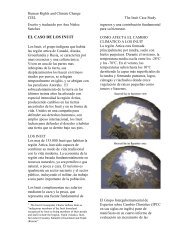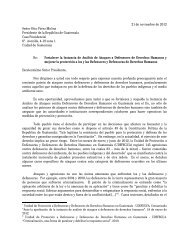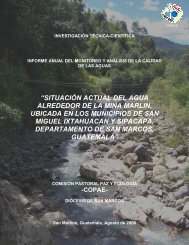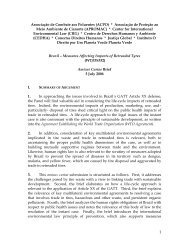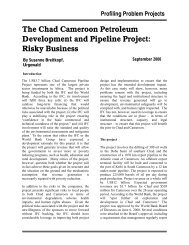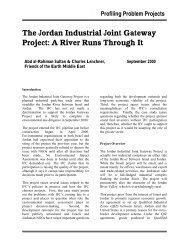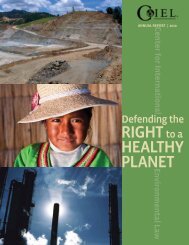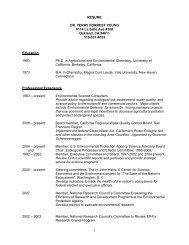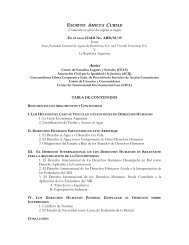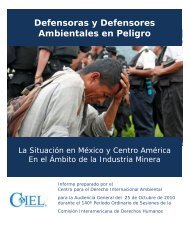Petition for Amicus Curiae Status in Case No. ARB/05/22
Petition for Amicus Curiae Status in Case No. ARB/05/22
Petition for Amicus Curiae Status in Case No. ARB/05/22
Create successful ePaper yourself
Turn your PDF publications into a flip-book with our unique Google optimized e-Paper software.
PETITION FOR AMICUS CURIAE STATUSIN CASE NO. <strong>ARB</strong>/<strong>05</strong>/<strong>22</strong> BEFORE THEINTERNATIONAL CENTRE FOR SETTLEMENT OF INVESTMENTDISPUTESBETWEENBIWATER GAUFF (TANZANIA) LIMITEDANDUNITED REPUBLIC OF TANZANIA<strong>Petition</strong>ers:The Lawyers' Environmental Action Team (LEAT)The Legal and Human Rights Centre (LHRC)The Tanzania Gender Network<strong>in</strong>g Programme (TGNP)The Center <strong>for</strong> International Environmental Law (CIEL)The International Institute <strong>for</strong> Susta<strong>in</strong>able Development (IISD)<strong>No</strong>vember 27, 2006<strong>Petition</strong>ers Represented by:Nathalie Bernasconi-OsterwalderCenter <strong>for</strong> International Environmental LawManag<strong>in</strong>g Attorney15 rue des Savoises12<strong>05</strong> Geneva, SwitzerlandTel: +41-<strong>22</strong>-789-<strong>05</strong>00Fax: + 41-<strong>22</strong>-789-0739Email: nbernasconi@ciel.orgHelen Kijo-BisimbaLegal and Human Rights CentreJustice Lugak<strong>in</strong>gira House, Kijitonyama AreaP.O Box 75254Dar es Salaam,TanzaniaTel: +255-2773038/48;Fax: +255-2773037Email: lhrc@humanrights.or.tzHoward MannSenior International Law AdvisorInternational Institute <strong>for</strong> Susta<strong>in</strong>ableDevelopment424 Hamilton Ave. SouthOttawa, OntarioCanada K1Y 1E3Tel: +1-613-729-0621Fax: +1-613-729-0306Email: h.mann@sympatico.caRugemeleza NshalaLawyers Environmental Action Team (LEAT)Senior Attorney52 W<strong>in</strong>chester AvenueNew Haven, CT 06511Tel:+203-745-4992Email: rugemeleza@yahoo.com
2PETITION FOR AMICUS CURIAE STATUSIN CASE NO. <strong>ARB</strong>/<strong>05</strong>/<strong>22</strong> BEFORE THEINTERNATIONAL CENTRE FOR SETTLEMENT OF INVESTMENT DISPUTESBETWEENBIWATER GAUFF (TANZANIA) LIMITEDANDUNITED REPUBLIC OF TANZANIACONTENTS OF PETITION1. ORDERS BEING SOUGHT2. PROCEDURE FOLLOWED IN THIS PETITION3. DESCRIPTION OF PETITIONERS4. REASONS FOR PETITION5. JURISDICTION TO ACCEPT AMICUS BRIEFS6. THE TEST TO APPLY IN THIS INSTANCE7. ACCESS TO THE KEY <strong>ARB</strong>ITRAL DOCUMENTS8. ACCESS TO THE ORAL HEARINGS9. SUMMARY OF PETITION AND ORDERS SOUGHT1. ORDERS BEING SOUGHTThe <strong>Petition</strong>ers are three Tanzanian-based legal non-governmental organizations (NGOs)and two <strong>in</strong>ternational NGOs. Act<strong>in</strong>g collectively, they are seek<strong>in</strong>g the follow<strong>in</strong>g orders of theTribunal <strong>in</strong> the present arbitration between Biwater Gauff (Tanzania) Limited v. United Republicof Tanzania, <strong>Case</strong> <strong>No</strong>. <strong>ARB</strong>/<strong>05</strong>/<strong>22</strong> be<strong>for</strong>e the International Centre <strong>for</strong> Settlement of InvestmentDisputes:o <strong>Status</strong> as amicus curiae <strong>in</strong> the present arbitration;o Access to the key arbitration documents; ando Permission to attend the oral hear<strong>in</strong>gs when they take place, and to reply to anyspecific questions of the Tribunal on the written submissions.2. PROCEDURE FOLLOWED IN THIS PETITIONAs will be discussed <strong>in</strong> more detail below, this petition is made pursuant to Rule 37(2) of therecently amended Rules of Procedure <strong>for</strong> Arbitration Proceed<strong>in</strong>gs (Arbitration Rules) of theInternational Centre <strong>for</strong> the Settlement of Investment Disputes. It is common ground that theseRules apply to the present arbitration. As will be addressed below, Rule 37(2) provides theauthority <strong>for</strong> this Tribunal to accept amicus curiae submissions. It sets out some tests <strong>for</strong> thispurpose that potential amici should address. However, no specific procedure <strong>for</strong> apply<strong>in</strong>g <strong>for</strong>amicus curiae status is set out, and no preset <strong>for</strong>ms are provided <strong>for</strong> this purpose. Moreover, asthis is the first <strong>in</strong>stance <strong>Petition</strong>ers are aware of where Rule 37(2) is be<strong>in</strong>g <strong>in</strong>voked, there are noprevious decisions apply<strong>in</strong>g its terms to guide the <strong>Petition</strong>ers.
3Consequently, the <strong>Petition</strong>ers have considered the scope and content of Rule 37(2), as well as thetwo decisions under the previous ICSID Arbitration Rules relat<strong>in</strong>g to acceptance of amicus curiaesubmissions. 1 These two decisions are by tribunals with identical membership and set outidentical procedures <strong>for</strong> this purpose. They seek from <strong>Petition</strong>ers <strong>for</strong> amicus status the follow<strong>in</strong>g:a. The identity and background of the petitioner, the nature of its membership if it is anorganization, and the nature of its relationships, if any, to the parties <strong>in</strong> the dispute.b. The nature of the petitioners’ <strong>in</strong>terest <strong>in</strong> the case.c. Whether the petitioner has received f<strong>in</strong>ancial or other material support from any ofthe parties or from any person connected with the parties <strong>in</strong> this case.d. The reasons why the tribunal should accept the petitioner’s amicus curiae brief. 2Us<strong>in</strong>g this as a guidel<strong>in</strong>e, this <strong>Petition</strong> sets out <strong>in</strong> Section 3 the elements referred to <strong>in</strong> paragraphs(a) and (c) above. Section 4 then addresses the issues raised <strong>in</strong> paragraph (b). The rema<strong>in</strong><strong>in</strong>gsections address the legal and procedural reasons that answer the question: Why should thetribunal accept the present <strong>Petition</strong>?3. DESCRIPTION OF THE PETITIONERSThe Lawyers' Environmental Action Team (LEAT) is the first and the premier public <strong>in</strong>terestenvironmental law organization <strong>in</strong> Tanzania. It was established <strong>in</strong> 1994 <strong>in</strong> Dar es Salaam,Tanzania, and is <strong>in</strong>corporated under the Companies Ord<strong>in</strong>ance Cap 212 as a company limited byguarantee. Its mission is to ensure sound natural resource management and environmentalprotection <strong>in</strong> Tanzania, thereby ensur<strong>in</strong>g that the constitutional and environmental rights of theTanzanian people are secured and realized by all. LEAT carries out policy research, advocacy,and selected public <strong>in</strong>terest litigation. Its membership is widely open to people who aim to furtherenvironmental protection <strong>in</strong> Tanzania, to advance the culture of sound natural resourcesmanagement and democratic governance. Its membership is ma<strong>in</strong>ly composed of lawyers fromthe private and not-<strong>for</strong>-profit sectors.LEAT is an <strong>in</strong>dependent organization which is not subject to direction or control by any otherorganization, but is open to partner with any public <strong>in</strong>terest organization <strong>in</strong> and outside thecountry <strong>in</strong> furtherance of its own mission and objectives. While LEAT seeks to work with thegovernment of Tanzania or other governmental units with<strong>in</strong> Tanzania on environmental andnatural resource management issues, it is not under or subject to control by any governmentagency.LEAT’S Public Interest Litigation Program seeks, on the one hand, to provide legal services tomembers of the public <strong>in</strong> Tanzania fac<strong>in</strong>g environmental degradation and human rightsviolations, and, on the other hand, to challenge <strong>in</strong>fr<strong>in</strong>gement of people’s rights, and the country’slaws and constitution. For example, <strong>in</strong> the case of LHRC, National Organizations <strong>for</strong> Legal Aid(NOLA) and LEAT v. Attorney General 3 LEAT and LHRC successfully argued be<strong>for</strong>e the HighCourt of Tanzania that the law allow<strong>in</strong>g political candidates to offer gifts and other <strong>in</strong>centives tothe electorate while canvass<strong>in</strong>g votes was unconstitutional. LEAT has also been <strong>in</strong> the <strong>for</strong>efront1 Aguas Argent<strong>in</strong>as et al. v. Argent<strong>in</strong>a, Order <strong>in</strong> response to a <strong>Petition</strong> <strong>for</strong> Transparency and Participation as<strong>Amicus</strong> <strong>Curiae</strong>, ICSID <strong>Case</strong> <strong>No</strong>. <strong>ARB</strong>/03/19 (19 May 20<strong>05</strong>); Aguas Prov<strong>in</strong>ciales de Santa Fe et al. v.Argent<strong>in</strong>a, Order <strong>in</strong> Response to a <strong>Petition</strong> <strong>for</strong> Participation as <strong>Amicus</strong> <strong>Curiae</strong>, ICSID <strong>Case</strong> <strong>No</strong>. <strong>ARB</strong>/03/17(17 March 2006).2 Aguas Argent<strong>in</strong>as, ibid, para. 25; Aguas Prov<strong>in</strong>ciales de Santa Fe, ibid, para. 24.3 High Court of Tanzania at Dar es Salaam Misc. Civil Cause <strong>No</strong> 77 of 20<strong>05</strong> (unreported).
4of fundamental re<strong>for</strong>ms of various laws <strong>in</strong> the country, <strong>in</strong>clud<strong>in</strong>g the enactment of major newenvironmental legislation <strong>in</strong> 2004.LEAT is f<strong>in</strong>anced by The Ford Foundation, Oxfam <strong>No</strong>vib (NL) and Blacksmith Institute (USA).Tundu Lissu is LEAT’s Act<strong>in</strong>g Executive Director and an Attorney at LEAT’s headquarters <strong>in</strong>Dar es Salaam Tanzania. Rugemeleza Nshala, act<strong>in</strong>g as co-counsel <strong>for</strong> the <strong>Petition</strong>ers <strong>in</strong> thepresent case, is the Senior Advocate at LEAT, currently based <strong>in</strong> New Haven, Connecticut. Theyboth have detailed knowledge of, and experience with, Tanzanian environmental laws and naturalresources management laws. In addition, both have <strong>in</strong>-depth knowledge on trade and <strong>in</strong>vestmentlaws and have closely followed <strong>in</strong>ternational trade and <strong>in</strong>vestment cases.Further <strong>in</strong><strong>for</strong>mation on LEAT’s activities and structure can be found at www.leat.or.tz.The Legal and Human Rights Centre (LHRC) is registered <strong>in</strong> Tanzania as a private, nongovernmental,non-partisan and non-profit mak<strong>in</strong>g organization. It has been an autonomous and<strong>in</strong>dependent entity s<strong>in</strong>ce its registration <strong>in</strong> September 1995. The Legal and Human Rights Centrewas established due to the realization that the majority of the people are unaware of their rights,and most importantly <strong>for</strong> the <strong>in</strong>digent who has no means to pursue his or her rights <strong>in</strong> court <strong>for</strong>want of legal representation.The Centre was created to contribute to the process of democratization <strong>in</strong> Tanzania and strives topromote, re<strong>in</strong><strong>for</strong>ce and safeguard human rights and democracy; promote respect <strong>for</strong> andobservance of the rule of law and due process; promote consumer protection; and create networkswith public <strong>in</strong>terest and human rights organization, non governmental organizations, universities,relevant research <strong>in</strong>stitutions, religious association and legal associations. It provides consultancyservices to Government and <strong>No</strong>n-Governmental Organizations with<strong>in</strong> the spirit of its objectives,and acts as a media resource on the issues with<strong>in</strong> its mandate. LHRC also provides legal aid andlegal and civic education to the members of the public, and plays a watchdog role <strong>in</strong> the arena ofhuman rights and issues of national concern.It runs radio and television programs on human rights, environmental protection, sound economicmanagement, and social welfare. It also collaborates with other public <strong>in</strong>terest organizations tolitigate on behalf of the public on matters of national importance and the protection of rule of law,legality and the country’s constitution. As mentioned above, <strong>in</strong> 2004, LHRC <strong>in</strong> collaboration withLEAT and NOLA successfully filed a constitutional petition aga<strong>in</strong>st the government of theUnited Republic of Tanzania aga<strong>in</strong>st the law that allowed political candidates to give gifts andother <strong>in</strong>centives while canvass<strong>in</strong>g <strong>for</strong> votes. LHRC has also successfully represented SerengetiDistrict residents that were <strong>for</strong>cefully evicted by the government of Tanzania from their landswithout compensation be<strong>for</strong>e the Tanzania Human Rights Commission.LHRC is not a membership based organization, but an <strong>in</strong>dependent non-governmentalorganization and is f<strong>in</strong>anced by the Ford Foundation, the governments of Sweden, F<strong>in</strong>land and<strong>No</strong>rway, as well as governmental and non-governmental organizations, such as Oxfam <strong>No</strong>vib(NL) and Equality <strong>No</strong>w (USA).Helen Kijo-Bisimba is LHRC’s Executive Director at its ma<strong>in</strong> office <strong>in</strong> Dar es Salaam Tanzaniaand a lawyer with vast experience on human rights issues. She will act as co-counsel <strong>for</strong> the<strong>Petition</strong>ers <strong>in</strong> the present <strong>in</strong>stance.More <strong>in</strong><strong>for</strong>mation on LHRC can be found at www.humanrights.or.tz.
5The Tanzania Gender Network<strong>in</strong>g Programme (TGNP), established <strong>in</strong> 1993, is a Tanzaniannon-governmental organization (NGO) work<strong>in</strong>g <strong>in</strong> the civil society sector, focus<strong>in</strong>g on thepractical promotion and application of gender equality and equity objectives through policyadvocacy and ma<strong>in</strong>stream<strong>in</strong>g of gender and pro-poor perspectives at all levels <strong>in</strong> Tanzaniansociety, <strong>in</strong>clud<strong>in</strong>g the public and governmental sectors. In particular, TGTN works on issuesrelat<strong>in</strong>g to access to water, especially <strong>for</strong> the poor and women. The organization strives toenhance the ma<strong>in</strong>stream<strong>in</strong>g of gender at all levels of society from grassroots communities to thehighest levels of national policy mak<strong>in</strong>g and legislation.TGNP’s overall vision is a f<strong>in</strong>al responsibility of its members who have an Annual GeneralMeet<strong>in</strong>g (AGM) every year. Day to day runn<strong>in</strong>g of the organization is directed by a Board whosesecretary is the Executive Director of TGNP, as Chief Executive of the organization responsible<strong>for</strong> the entire staff of TGNP. TGNP houses the Secretariat of FemAct, a strong Fem<strong>in</strong>ist Activistadvocacy coalition of more than 50 Tanzanian NGOs.TGNP is f<strong>in</strong>anced greatly by its member contributions <strong>in</strong> terms of annual membership fees,volunteerism and backstopp<strong>in</strong>g. Recent external donations have come from charities, foundationsand donors, <strong>in</strong>clud<strong>in</strong>g HIVOS/EU, CORDAID, SIDA, AIDOS, UNIFEM and Misereor, theUniversalist Unitarian Service Committee (UUSC), Women <strong>for</strong> Water (USA) the and Women <strong>for</strong>Water Secretariat <strong>in</strong> the Netherlands.More <strong>in</strong><strong>for</strong>mation on TGNP can be found at www.tgnp.org.The Center <strong>for</strong> International Environmental Law (CIEL) is a nonprofit 501(c)3 organizationunder the laws of the United States of America and the regulations of the US Internal RevenueService and <strong>in</strong>corporated as such <strong>in</strong> Wash<strong>in</strong>gton, District of Columbia, United States of America.CIEL has offices <strong>in</strong> Wash<strong>in</strong>gton, DC and Geneva work<strong>in</strong>g to provide legal support to persons andcivil society organizations around the world.CIEL is not a membership based organization, but an <strong>in</strong>dependent non-governmentalorganization. CIEL’s mission is to use <strong>in</strong>ternational law, <strong>in</strong>stitutions, and processes to protect theenvironment, human health and human rights, seek<strong>in</strong>g to create a just and susta<strong>in</strong>able world.Founded <strong>in</strong> 1989, CIEL plays a key leadership role <strong>in</strong> establish<strong>in</strong>g a firm foundation of legalanalysis to strengthen progressive ef<strong>for</strong>ts by civil society. CIEL provides a wide range ofservices to clients and partners, <strong>in</strong>clud<strong>in</strong>g legal counsel, analysis, policy research, advocacy,education, tra<strong>in</strong><strong>in</strong>g, and capacity build<strong>in</strong>g. The primary focus of this work is with develop<strong>in</strong>gcountry governments and civil society groups. CIEL staff are well-tra<strong>in</strong>ed <strong>in</strong> <strong>in</strong>ternational,common and civil law systems, come from five cont<strong>in</strong>ents, are of different cultural and religiousbackgrounds, and have broad legal perspectives due, <strong>in</strong>ter alia, to their diverse backgrounds andtra<strong>in</strong><strong>in</strong>g. Most have <strong>in</strong>ternational law experience work<strong>in</strong>g with their home governments as well.CIEL's Trade and Susta<strong>in</strong>able Development Program seeks to re<strong>for</strong>m the global framework ofeconomic law, <strong>in</strong> order to promote human development and a healthy environment. CIEL hasbeen engaged <strong>in</strong> <strong>in</strong>ternational trade and <strong>in</strong>vestment law issues s<strong>in</strong>ce the early 1990s, <strong>in</strong>clud<strong>in</strong>g <strong>for</strong><strong>in</strong>stance, participat<strong>in</strong>g <strong>in</strong> the first <strong>in</strong>vestor-state arbitration to allow amicus submissions,Methanex Corp. v. United States as well as <strong>in</strong> the Agua Argent<strong>in</strong>as v. Argent<strong>in</strong>a case. CIEL alsoprompted the WTO Appellate Body to recognize its authority to consider amicus curiae briefsfrom civil society <strong>in</strong> the landmark Shrimp/Turtle case.
6CIEL and its staff have published a number of papers and books on <strong>in</strong>ternational trade law and<strong>in</strong>ternational <strong>in</strong>vestment law, <strong>in</strong>clud<strong>in</strong>g most recently, Fresh Water and International EconomicLaw (Ox<strong>for</strong>d University Press, 20<strong>05</strong>), and Trade and Environment: A Guide to WTOJurisprudence (Earthscan, 20<strong>05</strong>).Fund<strong>in</strong>g <strong>for</strong> CIEL’s Trade & Susta<strong>in</strong>able Program is provided by foundations, <strong>in</strong>clud<strong>in</strong>g the JohnD. and Cather<strong>in</strong>e T. MacArthur Foundation, the Charles Stewart Mott Foundation, theRockefeller Foundation, and the Ford Foundation, as well as governments and <strong>in</strong>tergovernmentaland non-governmental organizations. CIEL reta<strong>in</strong>s full control over the content of its work andprojects, regardless of fund<strong>in</strong>g source.Nathalie Bernasconi-Osterwalder is the Manag<strong>in</strong>g Attorney of CIEL’s Geneva office. She will actas co-counsel <strong>for</strong> the <strong>Petition</strong>ers. She is an experienced <strong>in</strong>ternational lawyer and has previouslybeen <strong>in</strong>volved <strong>in</strong> amicus submissions <strong>in</strong> <strong>in</strong>vestment and trade law cases.More <strong>in</strong><strong>for</strong>mation on CIEL can be found at www.ciel.org.The International Institute <strong>for</strong> Susta<strong>in</strong>able Development (IISD) is a Canadian-based<strong>in</strong>ternational non-governmental organization orig<strong>in</strong>ally established by an Act of the Parliament ofCanada. The mandate of the IISD is to foster local, regional and <strong>in</strong>ternational policies andpractices <strong>in</strong> support of the achievement of susta<strong>in</strong>able development. IISD receives some corefund<strong>in</strong>g from the governments of Canada and Manitoba, as well as core and project fund<strong>in</strong>g froma wide range of governmental and non-governmental fund<strong>in</strong>g sources. IISD reta<strong>in</strong>s full controlover the content of its work and projects, regardless of fund<strong>in</strong>g source.Trade and <strong>in</strong>vestment agreements are one of several areas of work relat<strong>in</strong>g to susta<strong>in</strong>abledevelopment that IISD undertakes. IISD has been actively engaged <strong>in</strong> <strong>in</strong>ternational trade lawissues s<strong>in</strong>ce 1991, and <strong>in</strong>ternational <strong>in</strong>vestment law issues s<strong>in</strong>ce 1998. IISD’s primary concernswith the latter have been with regard to the relationship of <strong>in</strong>ternational <strong>in</strong>vestment agreements tosusta<strong>in</strong>able development. This <strong>in</strong>cludes the function<strong>in</strong>g and role of the dispute settlement systems,and the systemic legal implications of the <strong>in</strong>dividual and cumulative decisions of tribunals from asusta<strong>in</strong>able development perspective.IISD <strong>in</strong>itiated the first amicus curiae petition <strong>in</strong> the Methanex Corp. v. United States <strong>in</strong>vestorstatearbitration under NAFTA, and its amicus submissions <strong>in</strong> that case were expressly cited withapproval by the tribunal. 4 IISD is currently engaged <strong>in</strong> advis<strong>in</strong>g develop<strong>in</strong>g countries on<strong>in</strong>ternational <strong>in</strong>vestment law negotiations, a multi-partner process <strong>for</strong> tra<strong>in</strong><strong>in</strong>g on <strong>in</strong>ternational<strong>in</strong>vestment law, as well as work<strong>in</strong>g on a next generation of <strong>in</strong>ternational <strong>in</strong>vestment agreements.IISD staff have several dozen publications <strong>in</strong> this field, all of which are available athttp://www.iisd.org/publications/publication_list.aspx?themeid=7. IISD is also the publisher ofthe Investment Treaty News bullet<strong>in</strong>. 54 Methanex Corporation v. United States of America, F<strong>in</strong>al Award of the Tribunal on Jurisdiction andMerits, 3 August 20<strong>05</strong>, (here<strong>in</strong>after, F<strong>in</strong>al Award) Part IV, Chapter B, page 13, para. 27.http://naftaclaims.com/Disputes/USA/Methanex/Methanex_F<strong>in</strong>al_Award.pdf5 Investment Treaty News is a publication of IISD. Its editorial functions are kept separate from the otherwork of IISD <strong>in</strong> order to ensure neutral and objective report<strong>in</strong>g. It has previously published reports on thepresent arbitration. This was noted <strong>in</strong> Procedural Order <strong>No</strong>. 3 as part of the evidence produced by Biwatershow<strong>in</strong>g the risk of publication of <strong>in</strong><strong>for</strong>mation on the case. Investment Treaty News has, <strong>in</strong>deed, publishedsuch stories and will undoubtedly cont<strong>in</strong>ue to, as will other journals and news bullet<strong>in</strong>s <strong>in</strong> the field, as newdevelopments occur. Indeed, it would be rather unusual if there were no such report<strong>in</strong>g on a major<strong>in</strong>frastructure <strong>in</strong>vestment <strong>in</strong> the water sector that has gone awry and is now subject to an <strong>in</strong>ternational
7IISD’s fund<strong>in</strong>g <strong>for</strong> this work is derived from a project on capacity provision and capacity build<strong>in</strong>g<strong>for</strong> develop<strong>in</strong>g countries <strong>in</strong> relation to <strong>in</strong>ternational <strong>in</strong>vestment law. The project is funded by theRockefeller Brothers Foundation, and the development agencies of the governments of Swedenand Denmark, <strong>in</strong> particular.Howard Mann is the Senior International Law Advisor to IISD. A practic<strong>in</strong>g <strong>in</strong>ternational lawyer<strong>for</strong> nearly twenty years, Dr. Mann was counsel to IISD <strong>in</strong> the Methanex arbitration, has acted ascounsel <strong>in</strong> NAFTA-based litigation be<strong>for</strong>e Canada’s Federal Court of Appeal, and will also act asco-counsel <strong>for</strong> the <strong>Petition</strong>ers <strong>in</strong> the present <strong>in</strong>stance.More <strong>in</strong><strong>for</strong>mation on IISD can be found at www.iisd.org.Individually and collectively, the <strong>Petition</strong>ers hereby attest and affirm that they have norelationship, direct or <strong>in</strong>direct, with any party or any third party to this dispute. The<strong>Petition</strong>ers have not received any assistance, f<strong>in</strong>ancial or otherwise, from a party or a third partyto this dispute <strong>in</strong> the preparation of this <strong>Petition</strong> <strong>for</strong> <strong>Amicus</strong> <strong>Status</strong>. They will not receive any suchassistance <strong>in</strong> the preparation of their amicus submissions if this petition is accepted by theTribunal.4. REASONS FOR THE PETITIONThis arbitration raises a number of issues of vital concern to the local community <strong>in</strong> Tanzania,and a wide range of potential issues of concern to develop<strong>in</strong>g countries (and <strong>in</strong>deed all countries)that have privatized, or are contemplat<strong>in</strong>g a possible privatization of, water or other <strong>in</strong>frastructureservices. The arbitration also raises issues from a broader susta<strong>in</strong>able development perspectiveand is potentially of relevance <strong>for</strong> the entire <strong>in</strong>ternational community.In the UN Millennium Declaration, the <strong>in</strong>ternational community committed itself to halve, by theyear 2015, the proportion of people who are unable to reach or to af<strong>for</strong>d safe dr<strong>in</strong>k<strong>in</strong>g water. Theprivatization at issue <strong>in</strong> the present arbitration was conceived to work towards this goal. It hasbeen described as “one of the most ambitious <strong>in</strong> Africa and was <strong>in</strong>tended to be a model <strong>for</strong> howthe world's poorest communities could be lifted out of poverty and countries could meet theirmillennium development goal targets.” 6This was a critical project, watched by a wide range of observers. In few sectors is therelationship of service delivery to basic human rights and needs more salient than <strong>in</strong> the watersector. In addition, the management of water services relates closely to environmentalmanagement of water resources. Indeed, this Tribunal seems to implicitly recognize themultifaceted importance of this arbitration by explicitly not<strong>in</strong>g “the public nature of this disputeand the range of <strong>in</strong>terests that are potentially affected.” 7arbitration. We note the Tribunal has ensured that general discussion of the case be permitted under itsOrder as well. At no time has any allegation of impropriety, disruption or distortion been made towards thereport<strong>in</strong>g <strong>in</strong> ITN on the Biwater case.6 Flagship water privatisation fails <strong>in</strong> Tanzania, UK firm's contract cancelled amid row over supply, byJohn Vidal <strong>in</strong> Dar es Salaam, Wednesday May 25, 20<strong>05</strong>, The Guardian athttp://politics.guardian.co.uk/development/story/0,15709,1491602,00.html.7 Procedural Order <strong>No</strong>. 3, paragraph 147.
8This approach and understand<strong>in</strong>g of the issues has jurisprudential support. In Aguas Argent<strong>in</strong>as v.Argent<strong>in</strong>a, a dispute also <strong>in</strong>volv<strong>in</strong>g water distribution and sewage services, the tribunal stated <strong>in</strong>response to a petition <strong>for</strong> amicus status:“ … The factor that gives this case particular public <strong>in</strong>terest is that the <strong>in</strong>vestmentdispute centers around water distribution and sewage systems of a largemetropolitan area, the city of Buenos Aires and surround<strong>in</strong>g municipalities. Thosesystems provide basic public services to millions of people and as a result mayraise a variety of complex public and <strong>in</strong>ternational law questions, <strong>in</strong>clud<strong>in</strong>g humanrights considerations. Any decision rendered <strong>in</strong> this case, whether <strong>in</strong> favor of theClaimants or the Respondent, has the potential to affect the operation of thosesystems and thereby the public they serve”. 8Like the Aguas Argent<strong>in</strong>as case, the present dispute <strong>in</strong>volves a water services agreement. Theabove statement of the Aguas Argent<strong>in</strong>as tribunal stresses what is also true <strong>for</strong> the present dispute,namely that the arbitration process goes far beyond merely resolv<strong>in</strong>g commercial or privateconflicts, but rather has a substantial <strong>in</strong>fluence on the population’s ability to enjoy basic humanrights. This aspect of the case means that the process should be transparent and permit citizens’participation.Given the real and legitimate public concerns present <strong>in</strong> this case, 9 it is entirely appropriate thatthe Tribunal hear from the lead<strong>in</strong>g civil society groups <strong>in</strong> Tanzania on these issues. Thecomb<strong>in</strong>ation of natural resource and human rights issues is precisely what the Tanzanian<strong>Petition</strong>ers focus on <strong>in</strong> their day-to-day work. As locally based NGOs, they have the lead<strong>in</strong>gexpertise to identify and discuss the various <strong>in</strong>terests <strong>in</strong>volved <strong>in</strong> this dispute from a civil societyperspective. Indeed, this is what the Tanzanian NGOs have been do<strong>in</strong>g s<strong>in</strong>ce they wereestablished. These <strong>Petition</strong>ers br<strong>in</strong>g knowledge of local laws and circumstances, as well as thelocal context <strong>in</strong> which decisions on water services have been made.It is also appropriate that the Tribunal hear from <strong>Petition</strong>ers concerned with the implications ofthis dispute beyond the borders of Tanzania. This case potentially addresses Tanzania’s capacityto regulate and guarantee its citizens the supply of essential public services when they seek toenter partnerships with <strong>in</strong>vestors. But it is also potentially relevant <strong>for</strong> other develop<strong>in</strong>g countriesthat are currently fac<strong>in</strong>g massive <strong>in</strong>frastructure deficits. How <strong>in</strong>ternational <strong>in</strong>vestmentagreements, which by and large share similar structures and substantive content, can be applied togovern <strong>for</strong>eign <strong>in</strong>vestments <strong>in</strong> major <strong>in</strong>frastructure projects is of critical concern <strong>for</strong> thesusta<strong>in</strong>able development of these countries.In addition, the legal responsibilities of <strong>for</strong>eign <strong>in</strong>vestors <strong>in</strong> such projects are becom<strong>in</strong>g an<strong>in</strong>creas<strong>in</strong>gly important issue <strong>in</strong> the context of arbitrations concern<strong>in</strong>g such projects. What is thenature of the due diligence to be exercised by such <strong>in</strong>vestors be<strong>for</strong>e an <strong>in</strong>vestment is made, whatare the consequences <strong>for</strong> fail<strong>in</strong>g to meet the appropriate standards of conduct, and how could8 Paragraph 19 of Aguas Argent<strong>in</strong>as et al. v. Argent<strong>in</strong>a, Order <strong>in</strong> response to a <strong>Petition</strong> <strong>for</strong> Transparencyand Participation as <strong>Amicus</strong> <strong>Curiae</strong>, ICSID <strong>Case</strong> <strong>No</strong>. <strong>ARB</strong>/03/19 (19 May 20<strong>05</strong>).9 See, <strong>for</strong> <strong>in</strong>stance: Backlash over water Private Deals, by John Vidal, May 25, 20<strong>05</strong>, The Guardian,http://www.commondreams.org/headl<strong>in</strong>es<strong>05</strong>/<strong>05</strong>25-07.html;.Govt Dumps City Water, by Bilal Abdul-Azizof the Guardian, 14 May 20<strong>05</strong>, available at http://216.69.164.44/ipp/guardian/20<strong>05</strong>/<strong>05</strong>/14/39435.html; orAction Aid International, Turn<strong>in</strong>g Off the Taps Donor Conditionality and water privatisation <strong>in</strong> Dar esSalaam, Tanzania, available at http://www.actionaid.org.uk/_content/documents/Turn<strong>in</strong>gofftheTAps.pdf.
10procedure set out <strong>in</strong> such amended rules will apply to the question of amicus curiae.” (M<strong>in</strong>utes ofthe First Session, Para. 20.)<strong>Petition</strong>ers note that this is the first time, to their knowledge, that the new Rule 37(2) on amicussubmissions, which lays out the groundwork <strong>for</strong> an orderly process <strong>for</strong> consider<strong>in</strong>g theparticipation of amici, is be<strong>in</strong>g considered by a Tribunal. For this reason, we believe it is useful tomake some remarks on the new rule’s role, <strong>in</strong>terpretation and application.Firstly, we note that the jurisdiction of the Tribunal to accept amicus submissions is now beyonddoubt <strong>in</strong> these proceed<strong>in</strong>gs. S<strong>in</strong>ce 10 April 2006, the amended ICSID Arbitration Rules explicitlygive tribunals the power to allow <strong>for</strong> submissions of non-disput<strong>in</strong>g parties to the tribunal. Rule37(2) of the new ICSID Arbitration Rules provides, <strong>in</strong>ter alia:Submissions of <strong>No</strong>n-disput<strong>in</strong>g parties to the TribunalAfter consult<strong>in</strong>g both parties, the Tribunal may allow a person or entity that is nota party to the dispute (<strong>in</strong> this Rule called the “nondisput<strong>in</strong>g party”) to file a writtensubmission with the Tribunal regard<strong>in</strong>g a matter with<strong>in</strong> the scope of the dispute.This Rule is now expressly consistent with the practice that had emerged <strong>in</strong> previous arbitrations.This is so because the rule makes explicit not only that the Tribunal has the jurisdiction to acceptamicus curiae submissions, but also that it may do so without the approval of one or both of thearbitrat<strong>in</strong>g parties. 12 Rule 37(2) requires a tribunal to consult with the parties, but does not ascribeto either or both parties together a veto over a decision by a tribunal to exercise its discretion as itsees fit <strong>for</strong> the best result <strong>in</strong> the matter be<strong>for</strong>e it. This is consistent with the very notion of anamicus curiae, that it be a friend of the court, and serve the court’s purpose of a fully <strong>in</strong><strong>for</strong>meddecision.The <strong>in</strong>clusion of Rule 37(2) <strong>in</strong> the amended ICSID Rules must also, it is submitted, be understood<strong>in</strong> another light. By clarify<strong>in</strong>g the jurisdiction of ICSID Tribunals to accept such submissions, theRules also establish, by sound logic and necessary implication, the right of third parties to apply<strong>for</strong> such status. This third party right does not extend to the right to have such submissionsaccepted by the tribunal, or <strong>for</strong> them to <strong>for</strong>m a basis <strong>for</strong> the f<strong>in</strong>al award if they are accepted. But itdoes establish a right to make a full presentation to a tribunal to be able to meet the tests <strong>for</strong>acceptance as an amicus curiae that are set out <strong>in</strong> the balance of Rule 37(2). It is to this issue thatwe now turn.6. THE TEST TO APPLY IN THIS INSTANCERule 37(2) of the new ICSID Rules sets out the test <strong>for</strong> the Tribunal to apply <strong>in</strong> exercis<strong>in</strong>g itsdiscretion to accept or not accept any particular <strong>Petition</strong> <strong>for</strong> amicus curiae status. The full text ofRule 37(2) reads:After consult<strong>in</strong>g both parties, the Tribunal may allow a person or entity that is nota party to the dispute (<strong>in</strong> this Rule called the “nondisput<strong>in</strong>g party”) to file a writtensubmission with the Tribunal regard<strong>in</strong>g a matter with<strong>in</strong> the scope of the dispute. In12 The first decision to allow amicus participation <strong>in</strong> the Methanex Corp. v. United States arbitration wastaken, <strong>for</strong> example, aga<strong>in</strong>st the express wishes of the compla<strong>in</strong>ant corporation. Methanex Corporation v.United States of America, Decision of the Tribunal on <strong>Petition</strong>s From Third Persons to Intervene as Amici<strong>Curiae</strong>, January 15, 2001.http://naftaclaims.com/Disputes/USA/Methanex/MethanexDecisionReAuthority<strong>Amicus</strong>.pdf The sameapplies to the first two decisions on amicus curiae under the previous ICSID Rules, See Aguas Argent<strong>in</strong>asand Aguas Prov<strong>in</strong>ciales de Santa Fe, op.cit, note 1.
12new ICSID Rule, it falls to this Tribunal to sort out, as necessary, the k<strong>in</strong>ds of difficulties orlacunae that the <strong>in</strong>itial uses of the new Rules might highlight <strong>in</strong> practice. In this case, the questionarises of how to square the issuance of a broad confidentiality order with the exercise of the rightof non-parties to apply <strong>for</strong> status as an amicus curiae <strong>in</strong> a manner that complies with the letter andspirit of the new Rules that apply to this arbitration.It will not surprise the Tribunal that the <strong>Petition</strong>ers do not believe the confidentiality order isappropriate <strong>in</strong> a case of such broad public importance, or, <strong>in</strong>deed, <strong>in</strong> <strong>in</strong>vestor-state casesgenerally. At the same time, the <strong>Petition</strong>ers come to this process as it is and have no status toappeal the Order already made. Rather, the <strong>Petition</strong>ers here<strong>in</strong> suggest an appropriate way <strong>for</strong>wardto allow their rights to make a fulsome <strong>Petition</strong> <strong>for</strong> amicus status to be realized, <strong>in</strong> respect of theArbitral Rules controll<strong>in</strong>g this arbitration. Each element of the test noted above may beconsidered separately <strong>in</strong> this regard.(a) the non-disput<strong>in</strong>g party submission would assist the Tribunal <strong>in</strong> the determ<strong>in</strong>ation of a factualor legal issue related to the proceed<strong>in</strong>g by br<strong>in</strong>g<strong>in</strong>g a perspective, particular knowledge or<strong>in</strong>sight that is different from that of the disput<strong>in</strong>g partiesThe <strong>Petition</strong>ers fully appreciate the need to ensure that their submissions must assist theTribunal <strong>in</strong> determ<strong>in</strong><strong>in</strong>g matters properly be<strong>for</strong>e it. The <strong>Petition</strong>ers thus undertakeherewith to ensure that the matters they shall address will fall fully with<strong>in</strong> the legal issuesthe tribunal must address <strong>for</strong> a proper legal determ<strong>in</strong>ation <strong>in</strong> this case.However, at this time, it is impossible to demonstrate conclusively that the perspective ofthe <strong>Petition</strong>ers on any specific issue will differ from one of the parties. What has alreadybeen demonstrated, it is submitted, is that the start<strong>in</strong>g perspective of the <strong>Petition</strong>ers, asNGOs with specialized <strong>in</strong>terests and expertise <strong>in</strong> human rights, environmental and goodgovernance issues locally <strong>in</strong> Tanzania, and <strong>in</strong> the multiple critical <strong>in</strong>ter-relationshipsbetween <strong>in</strong>ternational <strong>in</strong>vestment law and susta<strong>in</strong>able development at the <strong>in</strong>ternationallevel, will be different than the <strong>in</strong>itial <strong>in</strong>terests, expertise and perspectives of the twocontend<strong>in</strong>g parties. One can and should anticipate that this will lead to different legalarguments be<strong>in</strong>g made. Where the differences <strong>in</strong> argument are <strong>in</strong>significant, the<strong>Petition</strong>ers undertake to exercise their discretion and refra<strong>in</strong> from mak<strong>in</strong>g submissions onsuch issues.(b) the non-disput<strong>in</strong>g party submission would address a matter with<strong>in</strong> the scope of thedispute<strong>Petition</strong>ers understand this to mean matters <strong>in</strong> the more limited sense of a factualor legal issue that is with<strong>in</strong> the scope of the dispute, not a political or broadlystatedpolicy issue. All the <strong>Petition</strong>ers can do at this time is aga<strong>in</strong> undertake toensure that this will be so. <strong>Petition</strong>ers and their counsel are all seasoned legalpractitioners with considerable experience <strong>in</strong>side legal processes at the nationaland <strong>in</strong>ternational levels. They respect this as a <strong>for</strong>um <strong>for</strong> legal issues with<strong>in</strong> thescope of the dispute.(c) the non-disput<strong>in</strong>g party has a significant <strong>in</strong>terest <strong>in</strong> the proceed<strong>in</strong>g<strong>Petition</strong>ers have relied upon their general knowledge of the case and the legal issues it islikely to raise, to demonstrate why the proceed<strong>in</strong>g has a significant <strong>in</strong>terest to them. In
13this regard, the public <strong>in</strong>terest <strong>in</strong>volved <strong>in</strong> the case is directly related to the sphere ofexpertise and mandate of the <strong>Petition</strong>ers. Based on what has been described above, wesubmit this test has been met.If the Tribunal is not satisfied that <strong>Petition</strong>ers have a significant <strong>in</strong>terest <strong>in</strong> the proceed<strong>in</strong>g or meetthe other tests, the Tribunal is requested to bear <strong>in</strong> m<strong>in</strong>d that the <strong>Petition</strong>ers cannot at this time bemore explicit due to no fault or lack of diligence on their own part. In this event, the <strong>Petition</strong>ersrespectfully suggest that the Tribunal consider one of two options:1. Accept<strong>in</strong>g the <strong>Petition</strong> now on the basis of the undertak<strong>in</strong>gs of the <strong>Petition</strong>ers set outabove and provid<strong>in</strong>g the <strong>Petition</strong>ers with the key legal documents <strong>in</strong> order to ensure thoseundertak<strong>in</strong>gs can be met and a useful submission can be made; or2. Provid<strong>in</strong>g <strong>Petition</strong>ers with the key legal documents <strong>in</strong> order that they may be able todemonstrate to the Tribunal that the tests are fully met be<strong>for</strong>e the Tribunal rules on thepetition.To ensure that either option will be effective, the Tribunal could issue a new procedural ordermodify<strong>in</strong>g the current restrictions on access to the arbitral documents under Procedural Order <strong>No</strong>.3; or the Tribunal could simply order the release of certa<strong>in</strong> documents, with or without specifiedconditions, as envisaged <strong>in</strong> Procedural Order <strong>No</strong>. 3.Given that Rule 37(2) does not exhaustively list the factors to be considered by the Tribunal <strong>in</strong>decid<strong>in</strong>g amicus status, the <strong>Petition</strong>ers wish to note two other factors that might be relevant to itsdecision on this <strong>Petition</strong>. 14 The first arises directly from the focus of the Tribunal <strong>in</strong> ProceduralOrder <strong>No</strong>. 3 on the proper function<strong>in</strong>g of the arbitral process. <strong>Petition</strong>ers wish to note <strong>in</strong> thisregard that there is a history of practice by amici that is grow<strong>in</strong>g <strong>in</strong> <strong>in</strong>vestor-state arbitrations. Inthe first such case, Methanex Corp v. United States, the f<strong>in</strong>al award of the Tribunal recorded their“appreciation of the scholarship and <strong>in</strong>dustry which counsel <strong>for</strong> the Disput<strong>in</strong>g Parties, Mexico andCanada as NAFTA Parties and the amici have deployed…” 15 , and also noted the attendance of theamici at the oral hear<strong>in</strong>g on the merits <strong>in</strong> that arbitration. As noted above, both CIEL and IISDappeared as amici be<strong>for</strong>e the Methanex Tribunal. 16It is this record of positive contribution, through what became simply a rout<strong>in</strong>e participation <strong>in</strong>the Methanex proceed<strong>in</strong>gs that the <strong>Petition</strong>ers wish to note. As well, with the number of amicuspetitions now <strong>in</strong>creas<strong>in</strong>g, and with a grow<strong>in</strong>g experience, there is no recorded <strong>in</strong>stance of theabuse of this process by any petitioner or accepted amicus curiae. There is no basis to assume theapplication of Rule 37(2) will lead to a disruption of the tribunal’s process. Indeed, to make suchan assumption and use it as a basis to deny amicus stand<strong>in</strong>g or access to the requisite documentsto participate <strong>in</strong> an <strong>in</strong><strong>for</strong>med manner would render the amendment to the Rules allow<strong>in</strong>g amicusparticipation <strong>in</strong>utile. Such a result would fit neither the letter nor spirit of the amendment. Wenote aga<strong>in</strong> <strong>in</strong> this respect the repeated assertions of this Tribunal <strong>in</strong> Procedural Order <strong>No</strong>. 3 that14 We note that Rule 37(2) states the Tribunal shall consider, “among other th<strong>in</strong>gs”, the factors set outexpressly <strong>in</strong> that Rule. Other factors may thus also be relevant. It may be noted that the tribunal <strong>in</strong> theAguas Argent<strong>in</strong>as and Aguas Prov<strong>in</strong>ciales de Santa Fe decisions, supra, n.1, para. 27 and 26 respectively(which predate the current Rules), listed several factors to consider: “…all the <strong>in</strong><strong>for</strong>mation <strong>in</strong> the petition,the views of the Claimants and Respondent; the extra burden which the acceptance of amicis curiae briefsmay place on the parties, the Tribunal and the proceed<strong>in</strong>gs; and the degree to which the proposed amicuscuriae brief is likely to assist the tribunal <strong>in</strong> arriv<strong>in</strong>g at its decision.”15 Methanex F<strong>in</strong>al Award, note 2 above, at p. Part I-preface-page 5.16 The Tribunal also, later on, expressly cited with approval the written submissions of IISD, see Footnote4, above, and accompany<strong>in</strong>g text.
14one of the overall purposes of the amendment to the Rules of Arbitration was to promote moretransparency <strong>in</strong> the <strong>in</strong>vestor-state process, not less than existed under the general mandate of thetribunal to manage its own process, the basis upon which Tribunals have previously allowedamicus participation.In addition, Rule 37(2) ascribes to the Tribunal the responsibility to manage the process so as toensure no disruption or procedural unfairness arises. In the absence of clear evidence of a highlikelihood of disruption, it is submitted that this factor, which motivated the Tribunal <strong>in</strong>Procedural Order <strong>No</strong>. 3, at least <strong>in</strong> large part, can only play a m<strong>in</strong>imal role <strong>in</strong> sett<strong>in</strong>g themodalities <strong>for</strong> such participation <strong>in</strong> any appraisal under Rule 37(2).F<strong>in</strong>ally, the <strong>Petition</strong>ers also note the importance of public access to such arbitrations from adifferent perspective; the credibility of the arbitration process <strong>in</strong> the eyes of the public. As noted<strong>in</strong> the Methanex Corp v. United States decision on jurisdiction to accept amicus submissions,49. There is undoubtedly public <strong>in</strong>terest <strong>in</strong> this arbitration. The substantive issues extend farbeyond those raised by the usual transnational arbitration between commercial parties.This is not merely because one of the Disput<strong>in</strong>g Parties is a State… The public <strong>in</strong>terest <strong>in</strong>this arbitration arises from its subject-matter, as powerfully suggested <strong>in</strong> the <strong>Petition</strong>s.There is also a broader argument, as suggested by the Respondent and Canada: theChapter 11 arbitral process could benefit from be<strong>in</strong>g perceived as more open ortransparent; or conversely be harmed if seen as unduly secretive. In this regard, thetribunal’s will<strong>in</strong>gness to receive amicus submissions might support the process <strong>in</strong>general and this arbitration <strong>in</strong> particular, whereas a blanket refusal could do positiveharm. 17The exact same argument is found <strong>in</strong> the only two decisions on amicus participation under theprevious ICSID Rules:The acceptance of amicus submissions would have the additional desirableconsequence of <strong>in</strong>creas<strong>in</strong>g the transparency of <strong>in</strong>vestor-state arbitration. Publicacceptance of the legitimacy of <strong>in</strong>ternational arbitral processes, particularly whenthey <strong>in</strong>volve states and matters of public <strong>in</strong>terest, is strengthened by <strong>in</strong>creasedopenness and <strong>in</strong>creased knowledge as to how the process functions…. Through theparticipation of appropriate representatives of civil society <strong>in</strong> appropriate cases,the public will ga<strong>in</strong> <strong>in</strong>creased understand<strong>in</strong>g of ICSID processes. 18This perspective from an <strong>in</strong>vestor-state tribunal is particularly important <strong>in</strong> light of the potentialimpacts of the confidentiality order on public access to documents <strong>in</strong> the case as it evolves. Whiletribunals and the <strong>in</strong>ternational arbitration bar often consider such issues from the perspective ofthe professional function<strong>in</strong>g of the <strong>in</strong>dividual case, as appears <strong>in</strong> the decision <strong>in</strong> Procedural Order<strong>No</strong>. 3 of this Tribunal, the public perception can be one of a system unfold<strong>in</strong>g <strong>in</strong> a secretenvironment that is anathema <strong>in</strong> a democratic context. Allow<strong>in</strong>g lead<strong>in</strong>g local and <strong>in</strong>ternationalNGOs amicus curiae status would help reduce the anxiety that accompanies such concerns andimprove the public credibility of the process.17 Methanex Corporation v. United States of America, Decision of the Tribunal on <strong>Petition</strong>s From ThirdPersons to Intervene as Amici <strong>Curiae</strong>, January 15, 2001.http://naftaclaims.com/Disputes/USA/Methanex/MethanexDecisionReAuthority<strong>Amicus</strong>.pdf18 Aguas Argent<strong>in</strong>as, n. 1, para <strong>22</strong>; Aguas Prov<strong>in</strong>ciales de Santa Fe, no. 1, para 21.
157. ACCESS TO THE KEY <strong>ARB</strong>ITRAL DOCUMENTSPursuant to Procedural Order <strong>No</strong>. 3 on confidentiality, <strong>Petition</strong>ers submit that the Tribunal <strong>in</strong> thepresent case has reta<strong>in</strong>ed the full authority and discretion to allow <strong>for</strong> access to documents to nondisput<strong>in</strong>gparties. In order to make an <strong>in</strong><strong>for</strong>med decision on whether to apply <strong>for</strong> participation asamici, we ask that the Tribunal exercise its discretion and provide access to:• the <strong>in</strong>itial notice of arbitration and statement of defense, if any was prepared;• the decisions, orders and directions of the Tribunal not already <strong>in</strong> the public doma<strong>in</strong>, ifany;• the plead<strong>in</strong>gs and written memorials of the arbitrat<strong>in</strong>g parties, and• relevant witness statements and transcripts of any witness exam<strong>in</strong>ations.In Procedural Order <strong>No</strong>. 3, the Tribunal explicitly allowed <strong>for</strong> “general discussion about the case”(para. 149-150). A “general discussion”, however, is <strong>in</strong>sufficient to provide a clear understand<strong>in</strong>gabout the specific legal issues this dispute raises, or the facts to which they must be applied so asto enable an <strong>in</strong><strong>for</strong>med and useful amicus brief to be prepared.Thus, the <strong>Petition</strong>ers turn to the Tribunal’s expressly reta<strong>in</strong>ed power to decide <strong>in</strong> favor ofdisclosure of the above types of arbitral documents. This is found <strong>in</strong> at least two relevant places <strong>in</strong>Procedural Order <strong>No</strong>. 3:ooAt para. 158, the Tribunal states that “this category of documents should berestricted, pend<strong>in</strong>g conclusion of the proceed<strong>in</strong>gs (or agreement between the parties,or further order by the Tribunal)”. [emphasis added.]At para. 162, the Tribunal expressly ma<strong>in</strong>ta<strong>in</strong>s <strong>for</strong> itself the cont<strong>in</strong>ued review of theapplication of its Order.In order to ensure that the balance between compet<strong>in</strong>g <strong>in</strong>terests isma<strong>in</strong>ta<strong>in</strong>ed, the tribunal considers it appropriate to keep each category[of documents described <strong>in</strong> the Order] under cont<strong>in</strong>ued review. To thisend, pend<strong>in</strong>g conclusion of these proceed<strong>in</strong>gs, the tribunal will act as“gate-keeper” on disclosures. Thus, if new circumstances arise, and theparties are unable to reach agreement, the parties rema<strong>in</strong> at liberty toapply to vary these directions on a case-by-case basis. In the <strong>in</strong>terests ofefficiency, the Tribunal expects that such applications would be madeonly <strong>in</strong> well-justified circumstances, supported by concrete explanations.While the above paragraph refers to applications <strong>for</strong> variances from the Order by the parties, <strong>in</strong>the present circumstances the <strong>Petition</strong>ers submit that this should not be read so as to limit thebroader notion of the Tribunal act<strong>in</strong>g as the gate-keeper on disclosures <strong>in</strong> the context of a <strong>Petition</strong><strong>for</strong> amicus stand<strong>in</strong>g. This would leave the ability of potential amici to engage <strong>in</strong> the process <strong>in</strong> aneffective manner <strong>in</strong> the hands of the parties rather than <strong>in</strong> the hands of the tribunal, where thediscretion has been fully vested by Rule 37(2) of the amended Rules.In addition, noth<strong>in</strong>g on the face of the Order suggests that the context of the second part of para.162 was drafted <strong>in</strong> anticipation of a <strong>Petition</strong> of the present type. Thus, <strong>in</strong> addition to read<strong>in</strong>g itwith<strong>in</strong> its <strong>in</strong>tended scope, it is submitted that the Tribunal may rely upon its general powers underRule 19 of the new Rules, to review its own orders <strong>in</strong> manag<strong>in</strong>g its proceed<strong>in</strong>gs, as well as the
16implied power <strong>in</strong> Rule 37(2) to ensure that amicus curiae have the opportunity to properly presenttheir petitions <strong>for</strong> said status and to make an effective contribution to the deliberations of theTribunal.<strong>Petition</strong>ers wish to note two additional factors relat<strong>in</strong>g to this issue. First, it has become commonpractice where arbitral documents are released to the public <strong>for</strong> confidential bus<strong>in</strong>ess <strong>in</strong><strong>for</strong>mationto be redacted. A similar process can be undertaken here. Experience suggests that <strong>in</strong> most cases,this is generally easily accomplished, and <strong>in</strong> reality few redactions are necessary.Second, <strong>Petition</strong>ers submit that “the balance between compet<strong>in</strong>g <strong>in</strong>terests”, as that phrase is used<strong>in</strong> para. 162 of Procedural Order <strong>No</strong>. 3, must also be understood to <strong>in</strong>clude the <strong>in</strong>terests ofpotential amici, act<strong>in</strong>g properly and fully with<strong>in</strong> their rights and <strong>in</strong>terests pursuant to Rule 37(2)of the Rules. That this adds an unanticipated twist to what the tribunal was address<strong>in</strong>g <strong>in</strong> its Orderis clear. That does not, however, dim<strong>in</strong>ish the compell<strong>in</strong>g need to address the impact Rule 37(2)should have on the scope or application of such an Order.8. ACCESS TO THE ORAL HEARINGSLastly, the <strong>Petition</strong>ers seek an Order from the Tribunal that the hear<strong>in</strong>gs be open to the public andthat amici, once accepted, be allowed to reply directly to any questions directed to them by theTribunal concern<strong>in</strong>g their submissions.Rule 32(2) of the amended Arbitration Rules provides:Unless either Party objects, the Tribunal, after consultation with the Secretary-General, may allow other persons, besides the parties, their agents, counsel andadvocates, witnesses and experts dur<strong>in</strong>g their testimony, and officers of theTribunal, to attend or observe all or part of the hear<strong>in</strong>gs, subject to appropriatelogistical arrangements. The Tribunal shall <strong>for</strong> such cases establish procedures <strong>for</strong>the protection of proprietary or privileged <strong>in</strong><strong>for</strong>mation.This provision is notably different from the previous Rule 32(2), which stated:The Tribunal shall decide, with the consent of the parties, which other personsbesides the parties, their agents, counsel and advocates, witnesses and expertsdur<strong>in</strong>g their testimony, and officers of the Tribunal may attend the hear<strong>in</strong>gs.Pr<strong>in</strong>cipally, the revised Rule enables the Tribunal to make a decision on its own <strong>in</strong>itiative to allowthird parties to attend the hear<strong>in</strong>g. Such a decision is then subject to an objection, or veto, by aparty. This difference, it is submitted, is emblematic of the overall shift to promot<strong>in</strong>gtransparency <strong>in</strong> <strong>in</strong>vestor-state arbitrations that this Tribunal has already noted <strong>in</strong> some detail <strong>in</strong> itsProcedural Order <strong>No</strong>. 3.The <strong>Petition</strong>ers, rely<strong>in</strong>g on the widely recognized public <strong>in</strong>terest <strong>in</strong> this arbitration, thus seek anOrder of the Tribunal <strong>for</strong> open proceed<strong>in</strong>gs, and <strong>for</strong> the enabl<strong>in</strong>g of the <strong>Petition</strong>ers and Counsel toattend the hear<strong>in</strong>g.In addition, <strong>Petition</strong>ers seek an Order to be allowed to respond to any questions on itssubmissions, should they be accepted by the Tribunal, at the oral hear<strong>in</strong>gs. <strong>Petition</strong>ers are aware
17that such a response can theoretically add some time. However, the Tribunal is master of its owntime, and can ensure that the proceed<strong>in</strong>gs are conducted <strong>in</strong> an orderly and timely fashion.<strong>Petition</strong>ers note that several <strong>in</strong>vestor-state cases have now been made open to the public, andthere has been no <strong>in</strong>cident or conduct that has disrupted the proceed<strong>in</strong>gs <strong>in</strong> any such case.Speculation that this case might lead to such disruptive conduct would be just that, baselessspeculation. In fact, <strong>in</strong> a grow<strong>in</strong>g and consistent practice <strong>in</strong> similarly emotional cases, nodisruption has occurred. <strong>Petition</strong>ers undertake to present their arguments <strong>in</strong> the time and mannerdirected by the Tribunal.9. SUMMARY OF PETITION AND ORDERS SOUGHTThe <strong>Petition</strong>ers seek the follow<strong>in</strong>g orders of the Tribunal <strong>in</strong> the present arbitration betweenBiwater Gauff (Tanzania) Limited v. United Republic of Tanzania, <strong>Case</strong> <strong>No</strong>. <strong>ARB</strong>/<strong>05</strong>/<strong>22</strong> at theInternational Centre <strong>for</strong> Settlement of Investment Disputes:o <strong>Status</strong> as amicus curiae <strong>in</strong> the present arbitration;o Access to the key arbitration documents; ando Permission to attend the oral hear<strong>in</strong>gs when they take place, and to reply to anyspecific questions of the Tribunal on the written submissions.In order to avoid disturb<strong>in</strong>g the orderly pace of this arbitration, and thus consistent with Rule37(2) of the new Arbitration Rules, <strong>Petition</strong>ers request access to the above-mentioned documentsas soon as possible.Respectfully submitted on behalf of:The Lawyers' Environmental Action Team (LEAT)The Legal and Human Rights Centre (LHRC)The Tanzania Gender Network<strong>in</strong>g Programme (TGNP)The Center <strong>for</strong> International Environmental Law (CIEL)The International Institute <strong>for</strong> Susta<strong>in</strong>able Development (IISD)Orig<strong>in</strong>al signed by Nathalie Bernasconi-OsterwalderCenter <strong>for</strong> International Environmental Law (CIEL)Geneva, 27 <strong>No</strong>vember, 2006
18CONTACTS:Center For International EnvironmentalLaw (CIEL)Nathalie Bernasconi-OsterwalderManag<strong>in</strong>g Attorney15 rue des Savoises12<strong>05</strong> Geneva, SwitzerlandTel: +41-<strong>22</strong>-789-<strong>05</strong>00Fax: + 41-<strong>22</strong>-789-0739Email: nbernasconi@ciel.orgInternational Institute <strong>for</strong> Susta<strong>in</strong>able(IISD)Howard MannSenior International Law AdvisorDevelopment424 Hamilton Ave SouthOttawa, OntarioCanada K1Y 1E3Tel: +1-613-729-0621Fax: +1-613-729-0306Email: h.mann@sympatico.caLawyers Environmental Action Team(LEAT)Tundu LissuAct<strong>in</strong>g Executive DirectorMaz<strong>in</strong>gira House, Maz<strong>in</strong>gira StreetMikocheni B AreaP.O Box 126<strong>05</strong>Dar es SalaamTanzaniaTel: +255-<strong>22</strong>-2780859/2781098Fax: 255-<strong>22</strong>-2780859Email:tundulissu@leattz.orgLegal and Human Rights Centre (LHRC)Helen Kijo-BisimbaP. O. Box 75254Dar es Salaam, TanzaniaPhone numbers: +255-<strong>22</strong> 2773038, 277 3048Fax number: +255-<strong>22</strong> 2773037http://www.humanrights.or.tz/Tanzania Gender Network<strong>in</strong>g Programme(TGNP)Mary Janeth RusimbiGender Resource CentreP.O. Box 8921Dar es Salaam, TanzaniaEast AfricaTel: +255-<strong>22</strong>-24432<strong>05</strong>, 2443450, 2443286Fax: +255-<strong>22</strong>-2443244http://tgnp.org



